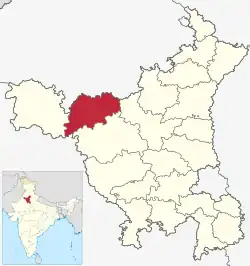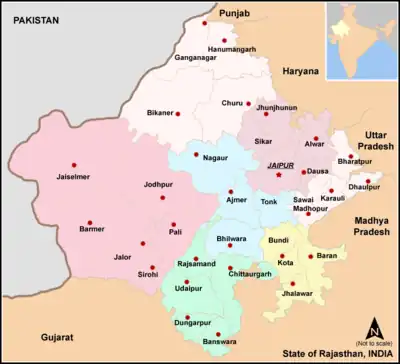| Bagri | |
|---|---|
| बागड़ी, باگری | |
 The word "Bagri" written in Devanagari script | |
| Native to | |
| Region | Bagar |
| Ethnicity | Bagri |
Native speakers | 1,890,815 (2011 census)[1] |
| Devanagari, Arabic script | |
| Language codes | |
| ISO 639-3 | bgq |
| Glottolog | bagr1243 |
The Bagri (बागड़ी / باگڑی) is a language that forms a dialect bridge between Haryanvi, Rajasthani, and Punjabi and takes its name from the Bagar tract region of Northwestern India.[2] The speakers are mostly in India, in the Sangaria,Rawatsar,Pilibanga,Nohar-Bhadra,Anupgarh, Hanumagarh , Northern tehsils of Bikaner and Sri Ganganagar district of Rajasthan , Sirsa and Fatehabad district Hisar,Bhiwani,Charkhi dadridistrict of Haryana, Fazilka district of Punjab in India.
Bagri is a typical Indo-Aryan language akin to Haryanvi, Punjabi and Rajasthani with SOV word order. The most striking phonological feature of Bagri is the presence of three lexical tones: high, mid, and low, akin to Punjabi.[3] The language has a very high (65%) lexical similarity with Haryanvi. According to the 2011 Census, there are 234,227 speakers of Bagri Rajasthani and 1,656,588 speakers of Punjabi Bagri.[4]
Features
Phonology
Bagri distinguishes 31 consonants including a retroflex series, 10 vowels, 2 diphthongs, and 3 tones.
| Labial | Dental | Retroflex | Palatal | Velar | Glottal | ||
|---|---|---|---|---|---|---|---|
| plosive | Voiceless | p | t | ʈ ⟨ṭ⟩ | c | k | |
| Aspirated | pʰ | tʰ | ʈʰ ⟨ṭh⟩ | cʰ | kʰ | ||
| Voiced | b | d | ɖ ⟨ḍ⟩ | ɟ ⟨j⟩ | g | ||
| Breathy | bʰ | dʰ | ɖʰ ⟨ḍh⟩ | ɟʰ ⟨jh⟩ | gʰ | ||
| fricative | s | h | |||||
| sonorant | Nasal | m | n | ɳ ⟨ṇ⟩ | |||
| Approximant | l | ɭ ⟨ḷ⟩ | j ⟨y⟩ | w | |||
| Flap | ɽ ⟨ṛ⟩ | ||||||
| Trill | r | ||||||
/ɳ/, /ɭ/ and /ɽ/ do not occur word initially.
| Front | Central | Back | |
|---|---|---|---|
| Close | iː ⟨ī⟩ | uː ⟨ū⟩ | |
| Near-close | ɪ ⟨i⟩ | ʊ ⟨u⟩ | |
| Close-mid | eː ⟨e⟩ | ə ⟨a⟩ | oː ⟨o⟩ |
| Open-mid | ɛː ⟨ai⟩ | ɔː ⟨au⟩ | |
| Open | aː ⟨ā⟩ |
All vowels have their nasalised counterpart, marked with ◌̃ (ँ in Devanagari).
Bagri has 3 tones in a similar way to the Punjabi language. A rising-falling tone ◌́, a rising tone ◌̀, and an unmarked mid tone.[5]
Declension
- There are two numbers: singular and plural.
- Two genders: masculine and feminine.
- Three cases: simple, oblique, and vocative. Case marking is partly inflectional and partly postpositional.
- Nouns are declined according to their final segments.
- All pronouns are inflected for number and case but gender is distinguished only in the third person singular pronouns.
- The third person pronouns are distinguished on the proximity/remoteness dimension in each gender.
- Adjectives are of two types: either ending in /-o/ or not.
- Cardinal numbers up to ten are inflected.
- Both present and past participles function as adjectives.
Verbs
- There are three tenses and four moods.
Syntax
- Sentence types are of traditional nature.
- Coordination and subordination are very important in complex sentences.
- Parallel lexicon are existing and are very important from sociolinguistic point of view.
Samples
तेरो
Tero
नाम
nām
के
ke
है
hai
What is your name?
किन्नै
kinne
जावै
jāve
है?
hai
Where are you going?
इन्नै
inne
/उरने
ā
आ
Come here Mismatch in the number of words between lines: 3 word(s) in line 1, 2 word(s) in line 2 (help);
क्यूकर
kyūkara
है?
hai
How are you?
तन्नै
tannai
कुचरणीं
kučaraṇīṃ
ही
hī
करनी
karni
है
hai
के?
ke
Do you only want to disturb things?
बातां
bātāṃ
गा
gā
पीसा
pīsā
लागै
lāgai
है.
hai
Talking costs money.
के
ke
करे
kare
है?
ha
What are you doing?
रोळो
rollo
है
ha
के
ke
कोई
koī
तेरै
terai
Do you have any problem?
तू
too
कठै
kathai
गयैड़ो
gayairo
हो
ho
Where did you go?
कठैउं
kaṭhū
/
ān
कडूं
lāga
आण
rahyo
लाग
ha
रह्यो
है?
Where are you coming from? Mismatch in the number of words between lines: 7 word(s) in line 1, 5 word(s) in line 2 (help);
भांडा
bhanda
Utensils
घोड़ो
Ghodo
होव
hov
जिओं
jiya
Like a horse
कोजवाड़
kojwād
Embarrassing.
ब्या
bayha
मे
mai
कुण
kun
आयो
aayo
Who came in the marriage?
टाबरो
tabaro
के
ke
करो
karo
हो
ho
What are you doing kids?
Official status
There are two varieties of Bagri, Bagri Rajasthani and Bagri Punjabi. During the census, Bagri Rajasthani, spoken in Haryana and Rajasthan, is considered a Hindi dialect while Bagri Punjabi, spoken in Punjab, is considered a Punjabi dialect.[4]
Work on Bagri
- Grierson, G. A. 1908. (Reprint 1968). Linguistic Survey of India. Volume IX, Part II. New Delhi: Motilal Banarasidass
- Gusain, Lakhan. 1994. Reflexives in Bagri. M.Phil. dissertation. New Delhi: Jawaharlal Nehru University
- Gusain, Lakhan. 1999. A Descriptive Grammar of Bagri. Ph.D. dissertation. New Delhi: Jawaharlal Nehru University
- Gusain, Lakhan. 2000a. Limitations of Literacy in Bagri. Nicholas Ostler & Blair Rudes (eds.). Endangered Languages and Literacy. Proceedings of the Fourth FEL Conference. University of North Carolina, Charlotte, 21–24 September 2000
- Gusain, Lakhan. 2000b. Bagri Grammar. Munich: Lincom Europa (Languages of the World/Materials, 384)
- Gusain, Lakhan. 2008. Bagri Learners' Reference Grammar. Ann Arbor, Michigan: Northside Publishers
- Wilson, J. 1883. Sirsa Settlement Report. Chandigarh: Government Press
Gallery
Regions where Bagri is spoken:
 Bagri is the First language in Sirsa district.
Bagri is the First language in Sirsa district.
 Bagri is the First language of Ganganagar district, Hanumangarh district, north-western part of Churu district and a major language in north-western part of Jhunjhunu district in Rajasthan.
Bagri is the First language of Ganganagar district, Hanumangarh district, north-western part of Churu district and a major language in north-western part of Jhunjhunu district in Rajasthan. Bagri is the major language in Fazilka district and as a minor language in southern villages of Muktsar district of Southern Punjab (India).
Bagri is the major language in Fazilka district and as a minor language in southern villages of Muktsar district of Southern Punjab (India).
See also
References
- ↑ "Statement 1: Abstract of speakers' strength of languages and mother tongues - 2011". www.censusindia.gov.in. Office of the Registrar General & Census Commissioner, India. Retrieved 7 July 2018.
- ↑ "Revised Land and Revenue Settlement of Hisar District 9006-9011" (PDF). Archived from the original (PDF) on 17 May 2017. Retrieved 26 March 2016.
- ↑ Gusain 2000, p. 14.
- 1 2 "LANGUAGE - INDIA, STATES AND UNION TERRITORIES (Table C-16)" (PDF). Census of India 2011. Archived from the original (PDF) on 12 July 2018.
- 1 2 3 Gusain, Lakhan. A Descriptive Grammar of Bagri. pp. 165–198.
Bibliography
- Gusain, Lakhan (1999). A Descriptive Grammar of Bagri (PhD). Jawaharlal Nehru University. hdl:10603/16847.
- Gusain, Lakhan (2000). Bagri. Languages of the world. Materials. Munich: LINCOM Europa. ISBN 978-3-89586-398-1.